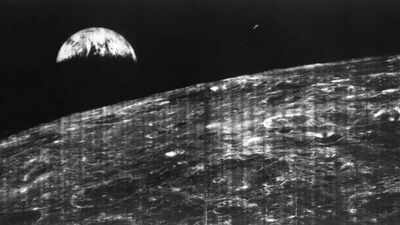It wasn’t a shiny color postcard or a sparsely deliberate shot. As an alternative, it was once a grainy black-and-white symbol, despatched throughout house in 1966, that absolutely reworked how humanity noticed itself. On August 23, 1966, NASA’s Lunar Orbiter 1 spacecraft snapped the first actual {photograph} of Earth as noticed from the Moon’s orbit. The image, our planet as a narrow crescent emerging above the lunar horizon, was once transmitted again to a flooring station close to Madrid, marking a quiet however ancient milestone. Consistent with NASA’s authentic recordsthe symbol was once captured right through the spacecraft’s sixteenth orbit, at the beginning as a part of a undertaking to scout touchdown websites for the Apollo program.What made this {photograph} atypical wasn’t its sharpness, however its point of view. For the primary time in historical past, humanity noticed Earth now not because the centre of the universe, however as a small, fragile sphere adrift in countless darkness. A long time later, the picture was once digitally restored via the Lunar Orbiter Symbol Restoration Challengehowever even in its uncooked shape, it stays a cosmic postcard, a reminder of simply how valuable and united our planet actually is.
The undertaking at the back of the primary view of Earth from the Moon
The Lunar Orbiter program was once introduced via NASA within the mid-Sixties with an overly sensible objective: to map the Moon’s floor in preparation for the Apollo landings. Lunar Orbiter 1, introduced on August 10, 1966, was once the primary in a chain of 5 spacecraft tasked with photographing doable touchdown zones.Its onboard digital camera device was once a changed model of a reconnaissance digital camera advanced right through the Chilly Conflict, designed to seize detailed photographs of the lunar terrain. However amid this severe medical paintings, engineers made up our minds to show the digital camera outward. The outcome was once unplanned, an image of Earth itself, placing above the Moon.That spontaneous selection gave the arena the primary view of Earth from the Moon, a point of view that no telescope on Earth may ever supply.
Why NASA’s first view of Earth from the Moon was once groundbreaking
In 1966, the general public had best ever noticed Earth represented on maps, globes, or from the restricted view of satellites in low Earth orbit. Seeing our house from just about 380,000 kilometres away was once not anything in need of modern.The picture introduced Earth as a mild crescent, very similar to how we see the Moon from Earth. It instantly challenged the geocentric mindset that had formed human historical past for hundreds of years. All of sudden, our planet seemed small, susceptible, and deeply interconnected.Whilst it didn’t obtain the similar cultural consideration as Apollo 8’s 1968 Earthrise picture, the Lunar Orbiter 1 shot prepared the ground. It proved that taking pictures Earth from the Moon was once conceivable and laid the basis for one of the vital maximum iconic house images ever taken.
Recovery of the primary view of Earth from the Moon
Via the 2000s, the unique information tapes from Lunar Orbiter 1 had begun to go to pot. In 2008, NASA, in partnership with a bunch of engineers and archivists, introduced the Lunar Orbiter Symbol Restoration Challenge (LOIRP).The use of refurbished tape drives and fashionable virtual era, they painstakingly restored the 1966 {photograph}, bettering its element and distinction. The outcome published extra readability within the Earth’s crescent and the lunar floor than somebody had noticed earlier than.This recovery now not best preserved a work of historical past but additionally highlighted the significance of archiving house information for long term generations.
Cultural and medical affect of the primary Earth picture from the Moon
The primary view of Earth from the Moon is greater than a milestone in house exploration; this can be a cultural artefact. Writers, scientists, and philosophers have mirrored on the way it altered humanity’s sense of position within the cosmos.In reality, Time mag as soon as famous that “geocentrism died on August 23, 1966.” That straightforward {photograph} underscored the truth that Earth isn’t the centre of the whole lot, it’s only one global amongst many in an infinite universe.Scientifically, the undertaking achieved its major objective of scouting Apollo touchdown websites. However symbolically, it presented one thing some distance higher: point of view. It sparked early discussions about Earth’s fragility, environmental stewardship, and the shared future of all folks residing on a unmarried planet.Just about six a long time later, the primary view of Earth from the Moon continues to encourage. Even in black-and-white, even with the restrictions of Sixties era, it captures one thing undying, the wonder and vulnerability of our best house.As of late, when high-definition photographs movement day by day from satellites and Mars rovers, it’s simple to fail to remember how radical this primary glimpse was once. However in 1966, it was once not anything not up to a revelation: Earth, emerging above the Moon, fragile and by myself within the cosmos.That {photograph} stays now not only a triumph of engineering however a reminder to seem again at our global with awe, humility, and accountability.Additionally learn| Why does a lizard’s indifferent tail continues to transport even after it falls off; know the science at the back of it

